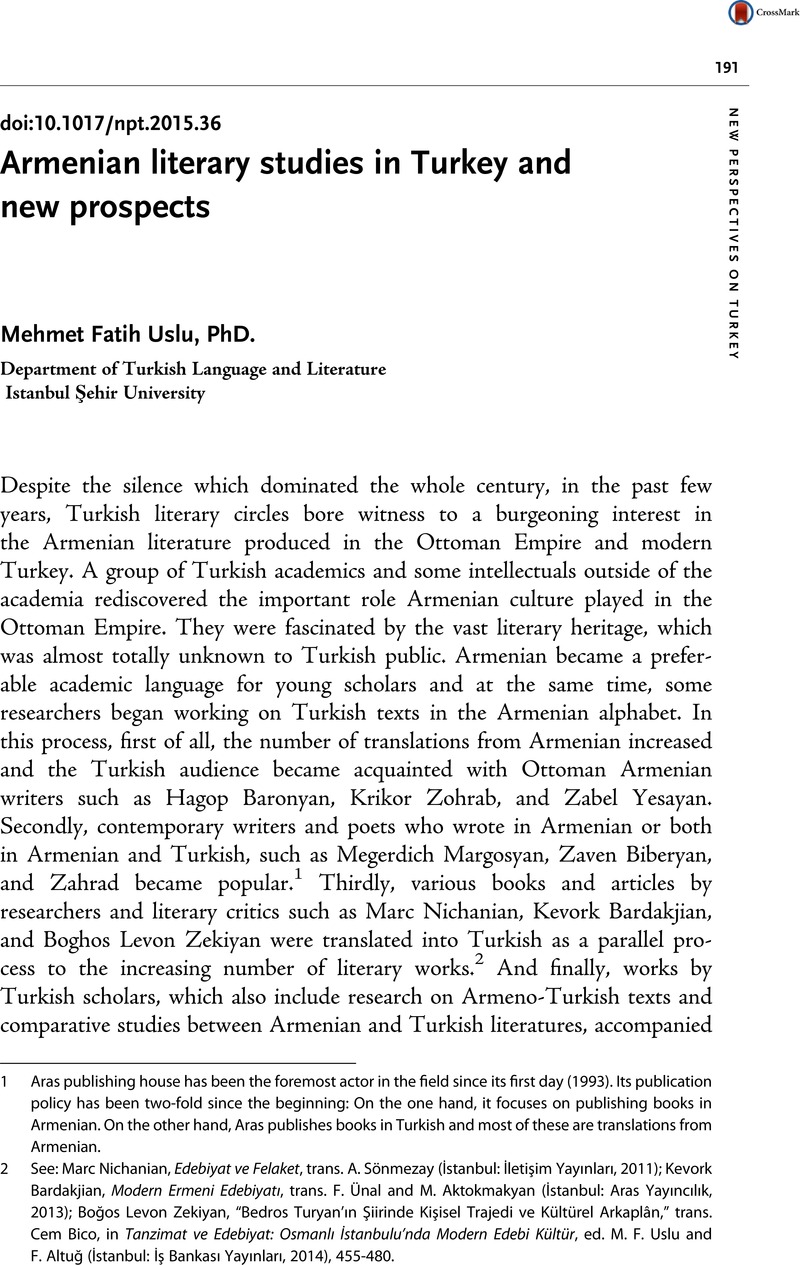Published online by Cambridge University Press: 30 December 2015

1 Aras publishing house has been the foremost actor in the field since its first day (1993). Its publication policy has been two-fold since the beginning: On the one hand, it focuses on publishing books in Armenian. On the other hand, Aras publishes books in Turkish and most of these are translations from Armenian.
2 See: Nichanian, Marc, Edebiyat ve Felaket, trans. A. Sönmezay (İstanbul: İletişim Yayınları, 2011)Google Scholar; Bardakjian, Kevork, Modern Ermeni Edebiyatı, trans. F. Ünal and M. Aktokmakyan (İstanbul: Aras Yayıncılık, 2013)Google Scholar; Zekiyan, Boğos Levon, “Bedros Turyan’ın Şiirinde Kişisel Trajedi ve Kültürel Arkaplân,” trans. Cem Bico, in Tanzimat ve Edebiyat: Osmanlı İstanbulu’nda Modern Edebi Kültür, ed. M. F. Uslu and F. Altuğ (İstanbul: İş Bankası Yayınları, 2014), 455-480Google Scholar.
3 Here, I would like to especially underline the pioneering contribution of Laurent Mignon who worked at Bilkent University until 2011. Mignon’s own work and his students’ writings created a growing interest in “Ottoman Literature(s)” in Turkish academic circles and brought about a challenging criticism to the Republican historiography regarding the literature of Turkey and of the Ottoman Empire. Mignon published extensively on literatures and literary cultures of non-Muslims in the Ottoman Empire and modern Turkey and helped to understand how nationalist history created an atmosphere of negligence for the local cultures of Anatolia and Istanbul. See: Mignon, Laurent, “A Pilgrim’s Progress: Armenian and Kurdish Literatures in Turkish and the Rewriting of Literary History,” Patterns of Prejudice vol. 48 (2014): 182-200CrossRefGoogle Scholar.
4 For an extensive account of Hrant Dink’s life and influence on Turkish intellectuals, see: Çandar, Tuba, Hrant, (İstanbul: Everest Yayınları, 2010)Google Scholar.
5 Manok, Yervant Baret, Doğu ile Batı Arasında San Lazzaro Sahnesi: İlk Türkçe Tiyatro Oyunları, trans. M. F. Uslu (İstanbul: bgst Yayınları, 2013)Google Scholar.
6 Emmez, Berivan Can, “Mıgırdiç Margosyan’ın Söyle Margos Nerelisen? Adlı Eserinde Diyarbakır ve Öteki İmgesi,” Batman Üniversitesi Yaşam Bilimleri Dergisi. Vol. 1 (2012): 145-157Google Scholar.
7 Esen, Nüket, “Mıgırdiç Margosyan and Mehmed Uzun: Remembering Cultural Pluralism in Diyarbakır,” New Perspectives on Turkey 36 (Spring 2007)CrossRefGoogle Scholar; Günay, Onur. “Yitik Bir Zamanın Peşinde: Gâvur Mahallesi.” Kitap-lık (April 2008)Google Scholar.
8 Nas, Alparslan, “Between National and Minor Literature in Turkey: Modes of Resistance in the Works of Mehmed Uzun and Mıgırdiç Margosyan,” (M.A. thesis, Sabancı University, 2011)Google Scholar.
9 In last years, Baronian has been translated and published by different publishing houses: Baronyan, Hagop, Şark Dişçisi, trans. Boğos Çalgıcıoğlu (İstanbul: Aras Yayıncılık, 2010)Google Scholar; Baronyan Oyunları, trans. M. F. Uslu and A. Sönmez (İstanbul: bgst Yayınları, 2013); İstanbul Mahallelerinde Bir Gezinti, trans. H. T. Babek, (İstanbul: Can Yayınları, 2014).
10 See Hazal Halavut’s M.A. thesis, which partly analyzes this gap between Yesayan’s fame and the unavailability of her literary corpus in Turkish: Towards a Literature of Absence. Literary Encounters with Zabel Yesayan and Halide Edib (M.A. thesis, Istanbul Bilgi University, 2012).
11 Paşa, Vartan, Akabi Hikayesi, Ed. Andreas Tietze (İstanbul: Eren Yayıncılık, 1991)Google Scholar.
12 For some earlier works on Armeno-Turkish literature, see: Kut, A. Turgut, “Ermeni Harfli Türkçe Telif ve Tercüme Konuları: I-Victor Hugo’nun Magdurin Hikâyesinin Kısaltılmış Nüshası”, in Besinci Milletler Arası Türkoloji Kongresi: Tebligler II Türk Edebiyatı. Volume I (Istanbul: Edebiyat Fakültesi 1985), 195–214Google Scholar. Gökalp, Gonca, “Osmanlı Dönemi Türk Romanının Başlangıcında Beş Eser”, Hacettepe Üniversitesi Edebiyat Fakültesi Dergisi, October 1999, 185–202Google Scholar. In last ten years, new theses and disserations on the issue also came out. For instance, see: Erğinci, Erkan, Metinler, “Öteki, Öteki Kadınlar: Ermeni Harfli Türkçe Romanlar ve Kadın İmgesi” (M.A. thesis, Bilkent University, 2007)Google Scholar. Murat Cankara’s work on Armeno-Turkish novels has been the most comprehensive work in this field. See: “İmparatorluk ve Roman: Ermeni Harfli Türkçe Romanları Osmanlı Türk Edebiyat Tarihi Yazımında Konumlandırmak” (Ph.D. diss., Bilkent University 2011).
13 For a recent compilation of articles on the modernization adventures of different Ottoman communities, see: Uslu, Mehmet Fatih and Altuğ, Fatih, eds. Tanzimat ve Edebiyat: Osmanlı İstanbulu’nda Modern Edebi Kültür (İstanbul: İş Bankası Yayınları, 2014)Google Scholar.
14 For a comparative work focusing on dramatic literature and its political implications in the 19th century, see: Uslu, Mehmet Fatih, Çatışma ve Müzakere: Osmanlı’da Türkçe ve Ermenice Dramatik Edebiyat, (İstanbul: İletişim, 2014)Google Scholar.
15 Srents, Sarkis, Ermeni Edebiyatı Numuneleri, (İstanbul: Aras Yayıncılık, 2013)Google Scholar.
16 Makarian, A., “Y. Odyani Padmakan Vepere,” in Yerkeri Joghovadzou. Volume II, (Yervant Odian, Yerevan, 1961): xvGoogle Scholar. For a recent Turkish version see: Odyan, Yervant, Abdulhamid ve Sherlock Holmes. Ed. S. Şahin et al. (İstanbul: Everest Yayınları, 2014)Google Scholar.
17 Marc Nichanian taught in Turkey for some time and had visible influence on Turkish intelectual circles. A good number of his articles have recently been translated and published in Turkish. See: Nichanian, Marc, Edebiyat ve Felaket, trans. A. Sönmezay, (İstanbul: İletişim Yayınları, 2011)Google Scholar.
18 Melissa Bilal and Lerna Ekmekçioğlu’s edited volume A Cry of Justice: Five Feminist Writers from the Ottoman Empire to Turkey was the earliest work in this field and evoked the curiosity of intellectuals who study Ottoman-Turkish women and their struggles. Bilal, M. and Ekmekçioğlu, L., ed., Bir Adalet Feryadı: Osmanlı’dan Türkiye’ye Beş Ermeni Feminist Yazar, (İstanbul: Aras Yayıncılık, 2006)Google Scholar.